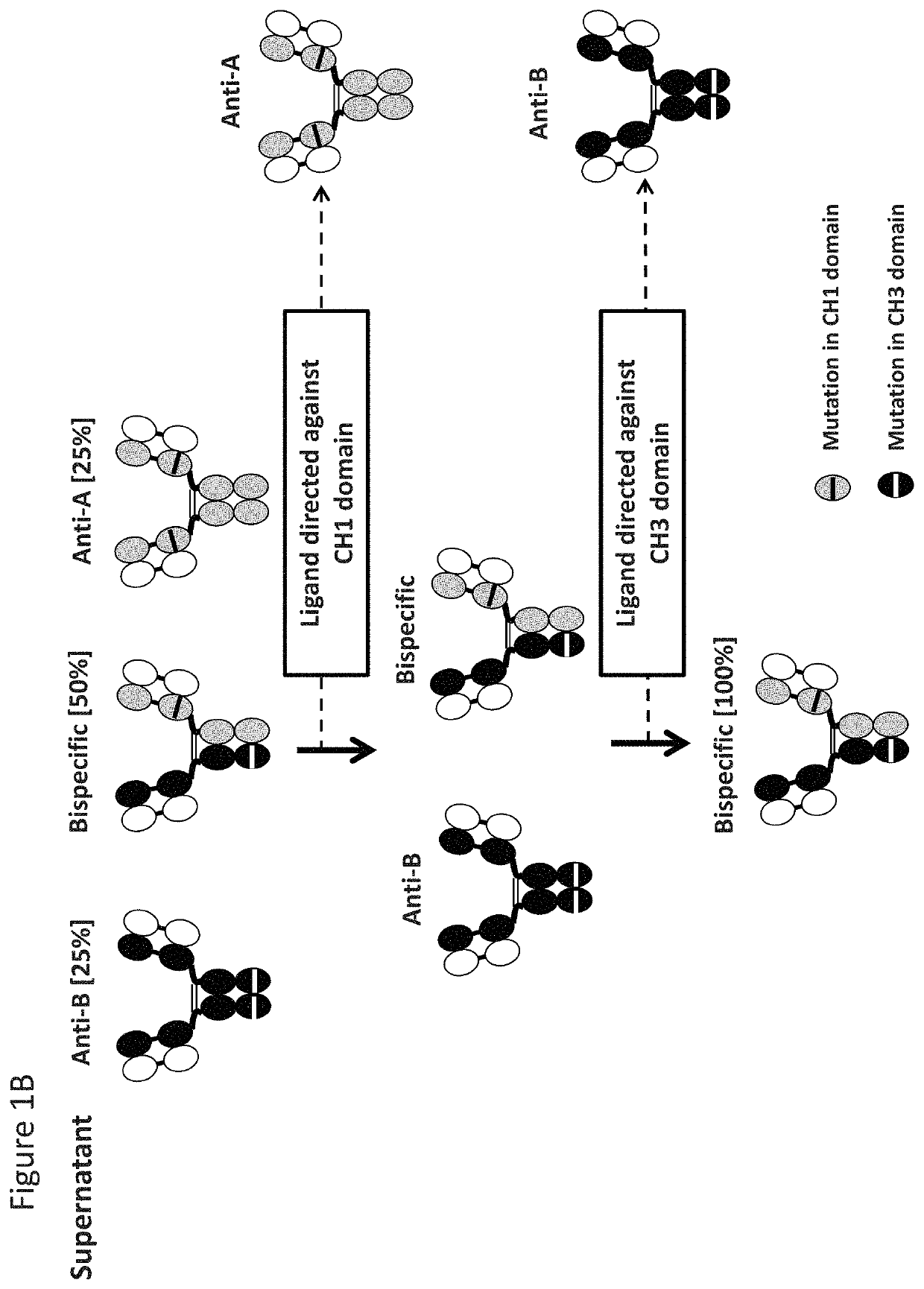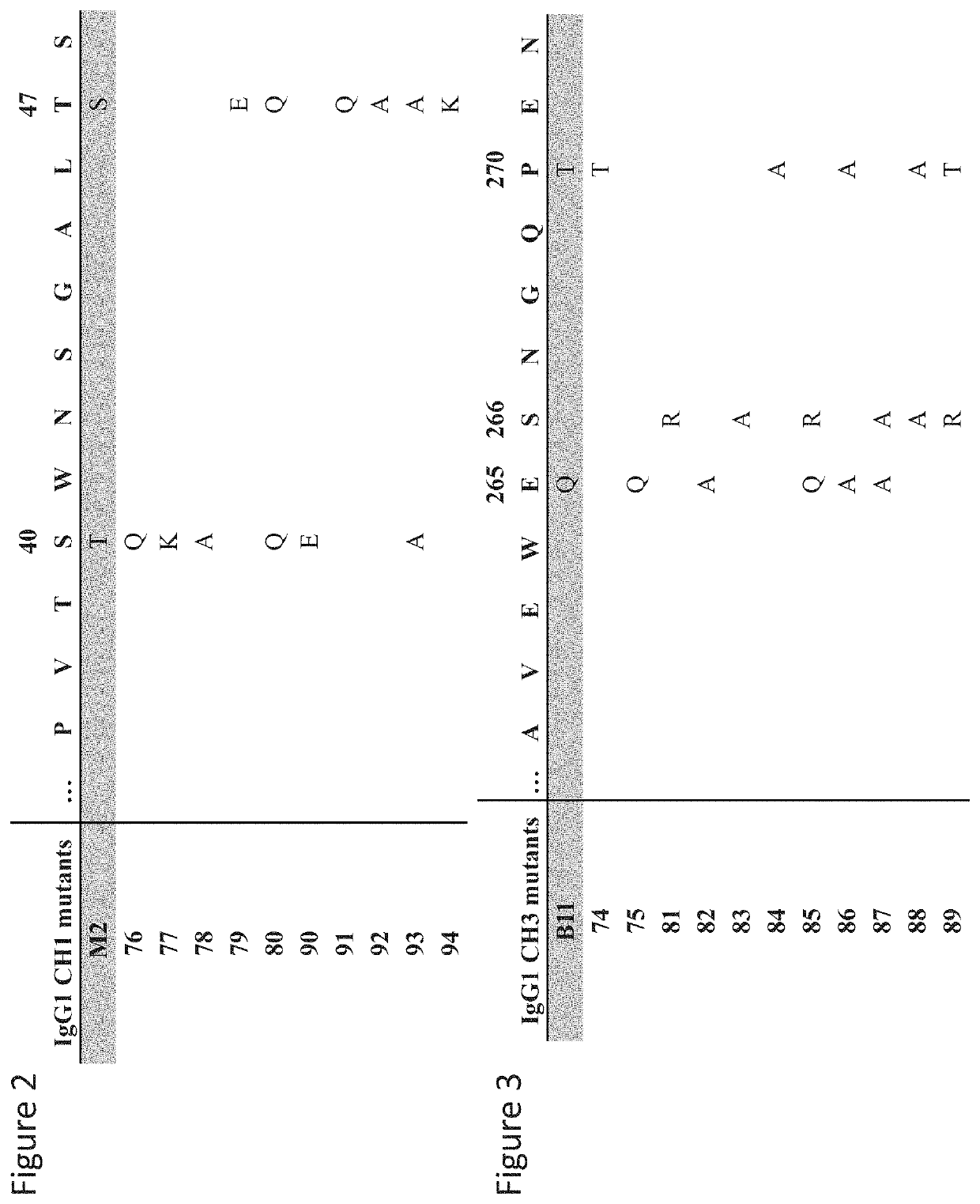Readily isolated bispecific binding molecules with native format having mutated constant regions
a technology of native format and binding molecules, applied in hybrid immunoglobulins, immunoglobulins against cell receptors/antigens/surface-determinants, cytokines/lymphokines/interferons, etc., can solve the problem that targeting or neutralizing a single protein is not always sufficient to achieve efficacy, and limits the therapeutic use of monoclonal antibodies. , to achieve the effect of improving the ability to quickly and effectively isolate the protein
- Summary
- Abstract
- Description
- Claims
- Application Information
AI Technical Summary
Benefits of technology
Problems solved by technology
Method used
Image
Examples
example 1
Design of an Asymmetric Purification Strategy for Bispecific Antibodies
[0112]Bispecific antibody composed of two different heavy chains and one common light chain can be expressed by co-transfection of three different chains: two different heavy chains and one common light chain. A mixture of three antibodies will result from this co-transfection: two parental monoclonal antibodies and one bispecific heterodimeric antibody (FIG. 1). To specifically purify the bispecific antibody from the mixture, two-step asymmetric affinity purification can be used to isolate the antibody of interest. Effectively, specific ligands targeting immunoglobulin domains like the CH1 and CH3 domains of the IgG heavy chains can be developed for affinity purification. Mutations introduced in the epitopes of specific ligands can be further introduced the IgG CH1 and CH3 domains to abrogate IgG binding to these CH1 and CH3 affinity reagents. Alternatively, a polypeptide containing an epitope binding region and...
example 2
Mutagenesis of CH1 and CH3 Domains
[0113]Mutations were introduced in the CHI (FIG. 2) and CH3 domain (FIG. 3) in order to abrogate binding to affinity reagents which are targeting these domains, the CaptureSelect® IgG-CH1 (aldehyde-activated agarose resin that specifically binds to human IgG-CH1 region) and the CaptureSelect® IgG Fc XL (aldehyde-activated agarose resin that specifically binds to human IgG-CH3 region), respectively. Single and double mutations were designed to either replace WT residue by alanine or by amino acids with longer and / or charged side chains like glutamine, glutamic acid, lysine and arginine. In addition, human IgG residues were also replaced by their equivalent murine IgG1 residues determined by sequence alignment between human and mouse IgG.
[0114]Single and double mutations in CH1 domain and CH3 domain of human IgG1, IgG2, IgG3 and IgG4 are indicated in sequence alignments represented in FIG. 4 and FIG. 5, respectively. These mutations are located in the...
example 3
Characterization of IgG1 CH1 Mutants
[0115]To determine if mutations introduced in the CH1 domain could abrogate binding to the CaptureSelect® IgG-CH1 resin, a screen was performed using Octet technology to measure the interaction of IgG1 variants with CaptureSelect® IgG-CH1 ligand. Streptavidin biosensors were coated with biotinylated CaptureSelect® IgG-CH1 ligand and variants of the IgG1 having mutations described in FIG. 2 were expressed in mammalian cells, purified using protein A and used at a normalized concentration of 10 g / ml. Several mutations in the CH1 domain led to significant reduction of the IgG binding to the ligand of the CaptureSelect® IgG-CH1 resin compared to WT IgG as shown on the sensorgram in FIG. 6. Indeed, at the exception of the mutant 93, modifications at positions 40 and 47 of the IgG CH1 domain decrease antibody association to the ligand of the CaptureSelect® IgG-CH1 resin. In parallel, antibody variants productivity was also monitored using Octet technolo...
PUM
| Property | Measurement | Unit |
|---|---|---|
| particle size | aaaaa | aaaaa |
| particle size | aaaaa | aaaaa |
| concentration | aaaaa | aaaaa |
Abstract
Description
Claims
Application Information
 Login to View More
Login to View More - R&D
- Intellectual Property
- Life Sciences
- Materials
- Tech Scout
- Unparalleled Data Quality
- Higher Quality Content
- 60% Fewer Hallucinations
Browse by: Latest US Patents, China's latest patents, Technical Efficacy Thesaurus, Application Domain, Technology Topic, Popular Technical Reports.
© 2025 PatSnap. All rights reserved.Legal|Privacy policy|Modern Slavery Act Transparency Statement|Sitemap|About US| Contact US: help@patsnap.com



